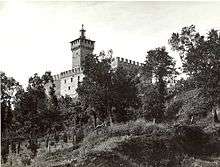Rocca delle Caminate
Rocca delle Caminate is a medieval castle located around 7 miles (11 km) from Predappio in the Emilia-Romagna region of Italy.[1]:99 It functioned as the summer home of Benito Mussolini, who was born in Predappio.

History
The Rocca delle Caminate was built in the 10th century, most likely on the site of a Roman fort.[2]
In 1927, the castle was donated to Benito Mussolini.[1]:99 It was then renovated by interior designer Guido Malagola Cappi.[3]:78 The external renovations included the addition of a lighthouse, which shone a powerful light whenever the Italian leader was present.[2]
It became Mussolini's summer residence in the area and he held meetings with dignitaries during World War II, such as Romanian Foreign Minister Mihai Antonescu, while staying there.[4]:652 The castle was also used as a site of torture, with members of the Italian resistance movement being beaten or killed there.[2] At the end of the war, it was partly destroyed by Allied troops in search of treasure, with the rest of the furniture being removed by locals.[5]
Following the war and Mussolini's death, his widow Rachele made efforts to sell the castle.[6]
21st century
Calls have been made for the castle's lighthouse to be restored to attract visitors, and Meldola mayor Gian Luca Zattini suggested parts of the castle be converted into a restaurant. The project was approved by the local government in 2017, but some critics suggested it could become a pilgrimage point for modern Fascists and seen as a celebration of Mussolini.[2]
References
- Gundle, Stephen; Duggan, Christopher; Pieri, Giuliana (2015). The cult of the Duce: Mussolini and the Italians. Manchester University Press. ISBN 978-1-5261-0141-9. Retrieved 12 July 2020.
- Squires, Nick (24 February 2017). "Furore in Italy over plan to renovate lighthouse that shone in honour of Mussolini". The Telegraph. Archived from the original on 14 January 2019. Retrieved 12 July 2020.
- Adriano, Pino; Cingolani, Giorgio; Vargiu, Riccardo James (2018). Nationalism and Terror: Ante Pavelić and Ustashe Terrorism from Fascism to the Cold War. Central European University Press. ISBN 978-963-386-206-3. Retrieved 12 July 2020.
- Linsenmeyer, William S. (1981). "Italian Peace Feelers before the Fall of Mussolini". Journal of Contemporary History. 16 (4). ISSN 0022-0094. Retrieved 12 July 2020.
- "Mussolini's Widow Wants a Buyer for a Ruined Castle". The San Francisco Examiner. 3 May 1959. p. 121. Retrieved 13 July 2020.
- "Forli, Italy". The Daily Oklahoman. 9 December 1956. p. 86. Retrieved 13 July 2020.